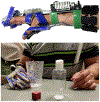User-Driven Functional Movement Training With a Wearable Hand Robot After Stroke
- PMID: 32886611
- PMCID: PMC8274060
- DOI: 10.1109/TNSRE.2020.3021691
User-Driven Functional Movement Training With a Wearable Hand Robot After Stroke
Abstract
We studied the performance of a robotic orthosis designed to assist the paretic hand after stroke. It is wearable and fully user-controlled, serving two possible roles: as a therapeutic tool that facilitates device-mediated hand exercises to recover neuromuscular function or as an assistive device for use in everyday activities to aid functional use of the hand. We present the clinical outcomes of a pilot study designed as a feasibility test for these hypotheses. 11 chronic stroke (>2 years) patients with moderate muscle tone (Modified Ashworth Scale ≤ 2 in upper extremity) engaged in a month-long training protocol using the orthosis. Individuals were evaluated using standardized outcome measures, both with and without orthosis assistance. Fugl-Meyer post intervention scores without robotic assistance showed improvement focused specifically at the distal joints of the upper limb, suggesting the use of the orthosis as a rehabilitative device for the hand. Action Research Arm Test scores post intervention with robotic assistance showed that the device may serve an assistive role in grasping tasks. These results highlight the potential for wearable and user-driven robotic hand orthoses to extend the use and training of the affected upper limb after stroke.
Figures






References
-
- Lawrence E, Coshall C, Dundas R, Stewart J, Rudd A, Howard R, and Wolfe C, “Estimates of the prevalence of acute stroke impairments and disability in a multiethnic population,” Stroke, vol. 32, 2001. - PubMed
-
- BROEKS JG, Lankhorst G, Rumping K, and Prevo A, “The long-term outcome of arm function after stroke: results of a follow-up study,” Disability and rehabilitation, vol. 21, no. 8, pp. 357–364, 1999. - PubMed
-
- Lang CE, Strube MJ, Bland MD, Waddell KJ, Cherry-Allen KM, Nudo RJ, Dromerick AW, and Birkenmeier RL, “Dose response of task-specific upper limb training in people at least 6 months poststroke: A phase ii, single-blind, randomized, controlled trial,” Annals of neurology, vol. 80, no. 3, pp. 342–354, 2016. - PMC - PubMed
-
- Schneider EJ, Lannin NA, Ada L, and Schmidt J, “Increasing the amount of usual rehabilitation improves activity after stroke: a systematic review,” Journal of physiotherapy, vol. 62, no. 4, 2016. - PubMed
-
- Levanon G, Colijn B, Cheng B, and Paterra M, “From not enough jobs to not enough workers: What retiring baby boomers and the coming labor shortage mean for your company,” The Conference Board Market Report, https://www.conference-board.org/topics/publicationdetail.cfm?publicatio..., 2014.
Publication types
MeSH terms
Grants and funding
LinkOut - more resources
Full Text Sources
Medical

